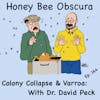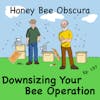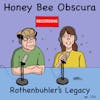Dealing With Wax Moths (088)

Post-harvest time is a good time to look for wax moth in your colonies. Believe it or not, wax moths are around pretty much all of the time. On today’s episode, Kim and Jim discuss wax moths! Strong colonies keep them pretty much under control, but...
Post-harvest time is a good time to look for wax moth in your colonies. Believe it or not, wax moths are around pretty much all of the time. On today’s episode, Kim and Jim discuss wax moths!
Strong colonies keep them pretty much under control, but weak colonies sometimes can’t keep up and soon they’ll have more wax moth larvae than honey bees.
Stored equipment is another challenge. Some beekeepers will freeze supers after harvest to kill any moth larvae before storing them away for the winter. If you have unheated winter storage you can pretty much avoid problems – if it gets below freezing before the wax moths take over. But if you have mild winters, you need to stack your supers so they get fresh air and light all the time. Fresh air and light are a moth’s worst enemies, so keep your combs exposed.
There are control products you can consider and use, too.
Moths can be beneficial. They can quickly clean up old comb for you! Plus, the larvae are great fish bait!
Wax moths are a natural part of the bee ecosystem. Learning how to work with them is a part of beekeeping.
We hope you enjoyed today's episode. Please follow or subscribe today and leave a comment. We'd love to hear from you!
___________________
Thanks to Betterbee for sponsoring today's episode. Betterbee’s mission is to support every beekeeper with excellent customer service, continued education and quality equipment. From their colorful and informative catalog to their support of beekeeper educational activities, including this podcast series, Betterbee truly is Beekeepers Serving Beekeepers. See for yourself at www.betterbee.com
______________________
Honey Bee Obscura is brought to you by Growing Planet Media, LLC, the home of Beekeeping Today Podcast.
Music: Heart & Soul by Gyom, Walking in Paris by Studio Le Bus, original guitar music by Jeffrey Ott
Copyright © 2022 by Growing Planet Media, LLC

Episode 88 – Dealing With Wax Moths
[music]
Jim Tew: Kim, I got a call from a friend saying he had wax moths, so I guess it's that time of the year.
Kim Flottum: Yes. After harvest fall, the end of summer, there's more of them, and you got to do something.
Jim: Yes. It happens every season, so they're pretty much right on schedule, there's no surprises.
Kim: I wonder what would happen if they didn't show up.
Jim: [chuckles] I wouldn't believe it. I think I'd done something wrong. If you got time, let's talk about it.
Kim: All right.
Jim: Hi, I'm Jim Tew.
Kim: And I'm Kim Flottum.
Jim: We're coming to you from Honey Bee Obscura, where today, we want to just chat about wax moths, it's that time of the year.
Introduction: You are listening to Honey Bee Obscura brought to you by Growing Planet Media, the folks behind Beekeeping Today Podcast. Each week on Honey Bee Obscura, hosts Kim Flottum and Jim Tew explore the complexities, the beauty, the fun, and the challenges of managing honeybees in today's world. Get ready for an engaging discussion to delight and inform all beekeepers. If you're a longtimer or just starting out, sit back and enjoy the next several minutes as Kim and Jim explore all things honeybees.
Jim: Kim, I don't know what to say. These are old friends. Wax moth is very well adapted to beehives. They were in my earliest years of beekeeping back when American foulbrood, and European foulbrood, and wax moths were the only three pests I had. Just like Varroa, you can't kill them, you can't beat them, so you just learn to live with them.
Kim: I live with them, but I got to tell you, a couple of things that I do is the way I stack my equipment, air and light, it's on my equipment when it's stacked off for all season or just being stored. Sometimes, I want wax moth. I got old frames. I use plastic foundation and they clean up old comb off plastic foundation just fine.
Jim: Yes. I agree with you. When you and I thought about talking about wax moths today, I went back to both the books, ABC, and The Hive And The Honey-Bee, and just had a quick look. There is no mention of air and light, at least in one of the books, but I have done that all my life. I distinctly remember a recommendation from an old beekeeper that he put his unused equipment and the loft of his barn, and he left both gable doors open. There was some light, and there was air moving through the upper level of the barn out of the way. He said he had no problem with wax moths. I'm not trying to sell that to the listeners, but I'm saying that this light and air thing seems to be pretty much in the literature.
Kim: We've got friends in California that actually stack their supers with both the top and the bottom exposed. The super sits on its side, on a rack, and they've got two levels in there. The top and the bottom is completely exposed all during storage. Then it gets a little rain out there, that's not a problem. Wax moths just isn't there, so light and air works if you got the room.
Jim: Here's the truth. As we speak, I've got some of my equipment, mostly deeps and a few shallows, a few mediums, and they're sitting on their ends. The top and the bottom of the frames are exposed. It doesn't make for a neat-looking yard to have all this equipment sitting around. Some of the listeners might say, "Hey, Jim, why don't you just put that in the barn and close it up and put PDB crystals on it or paradichlorobenzene?"
Then, Kim, I enter the mouse world because when I put that equipment in the dark barn and even try to control the wax moth that way, then I got to start fighting mice. I just swap one problem for another. As you say, I leave this sitting outside on the end, but it makes an unsightly picture when I'm photographing queen replacement or making a video for something. There's all this junky equipment sitting around. It doesn't make for a nice picture.
Kim: [laughs] Yes, I suppose, but I don't know a better way to do it. I'm not putting poison in my beehive with those crystals that you're talking about, and I don't have problems. I have to control mice where I store a lot of things, my garage, and my chicken coop. I have to control mice year round. I've always mouse bait out, and that pretty much takes care of the mice for me. You can get these mouse bait things that are-- you can let your kids play with them and they're safe. I don't worry about that. I control the mice, and my boxes stay mothless all year. Now, there's something else going on that just started up here is that new Certan.
Jim: Yes. I didn't know much about that until you turned me onto it. Kim, we're not selling this, we're not promoting it, we're just talking about it and letting others listen in while we do it. Whether or not they decide to use it is strictly up to them. Apparently, it's a numbered compound called B, the letter B402. It's the Certan name. You and I both remember Certan, an original product years ago is a Bt product, Bacillus thuringiensis, a Bt product, but you're the one who found the information, you talk about it.
Kim: You're right. It's a numbered product, number given to it by the people who sorted it out. It's a bacteria, and you apply it to your comb. When the wax moth larva consume the comb, they also consume the bacteria, and it kills the wax moth larva internally. It's not a poison as far as bees are concerned, it has nothing to do with bees. I wouldn't mind using it because it's not a poison, but it works quite well. You will have a little bit of wax moth damage, but then you won't have anymore because it pretty much cleans them up.
Jim: I think it needs to be said that wax moths are in the hives all the time, and a good, healthy hive fights them day in and day out. I guess we could say is all in a day's work for a good, strong bee hive to take out the daily wax moth larvae that are trying to make a go of it. It's only when something goes wrong, queenless, Varroa mites, pesticide exposure that the colony weakens that the wax moth were able to get a foothold. It's not really that the wax moth kill the colony, they just finished the colony's demise, but the colony was already weakened from something else.
Kim: That's pretty common. A good way to use that information is if you were open your colony and you see four or five wax moth larva in the inner cover or on the top bars, in the box of the top box, you know something's going on because normally, the bees keep those things pretty well under control, and you're not going to see larva that are an inch long and big enough to eat a box. You can use wax moth as a warning sign, if you will, that something's wrong with your colony.
Jim: Let's take a break, hear from our sponsor. When we come back, we'll talk about those warning signs and how they use wax moth to clean up old frames.
Betterbee: Looking forward to reaping the benefits of your hard work by harvesting honey? Sure, you are, but getting the process started can be daunting. That's why Betterbee is here to help. We've teamed up with our friends over at Bee Smart Designs to offer a beginner's extracting kit. Especially for you because you listen to this podcast, you'll get 30% off regular pricing but only through August 30th, 2022. Go now and order your kit. It includes our two-frame plastic extractor, the Bee Smart Designs uncapper combo, a plastic honey sieve, and a 5-gallon pale with a honey gate. Visit betterbee.com/begin to make extracting easy.
Jim: You said I better go that you didn't mind some wax moth activity because they destroyed that old black comb that you wanted to recycle. Is that an easy process that you're using, or is it a random thing? The wax moth choose the frames, or do you choose the frames?
Kim: I choose the frames, and I do it intentionally, and I do it with, I think I'll say some precision. I take a cover, and I'll put a box or two or three or four on it. Then I'll put another cover on top of the top box, and then I will-- depending, if I just took the box off a colony, I'm pretty sure there's going to be moths in it or moth larva in it. If it's been sitting for a while, it may not have any or not nearly enough.
What I will do is I will make a crack between two of those boxes so an adult wax moth can get in there and lay eggs. If it works the way I think it should, I'll leave them there about a month, and I'll come back, and there'll be nothing but frames and wax foundation and a pile of garbage, dead moths, dead larva, what would you call larval-- [chuckles]
Jim: Frass. [laughs]
Kim: Frass. Yes, larval frass. It'll be a pile of that on the bottom, but it's all captured in that cover that I put down there in the first place, which is why I put it there. I move the boxes off. I take the cover, I throw the stuff outside, scrape it clean, and I'm ready to go. I've got boxes of relatively clean frames without it, all that old comb.
Jim: Yes. Beekeepers are polarized on this to a degree, but there's one school of thought that in the wild, a wax moth is potentially a beneficial insect pest. For a while, honey bee colonies, because you and I've talked, these wild colonies die all the time. Wax moths are there on the spot to clean up that old comb, destroy it, break it down, so perchance, if they died from American foulbrood, they may scatter that inoculum some so that it's not as infectious as it would've been.
Now, that's the arguing point. Some beekeeper say, "No, it's not scattered enough at all. You can't have it. That hollow tree will always be infectious." Other beekeepers say, "No, it's the bacterial spores are not in the right place. It's pretty safe for another colony to use that nest cavity." There it is. Are they beneficial in the wild or not? Because they make those bees recycle that comb that was in the nest that failed.
Kim: You look at it like that, and they absolutely are beneficial. It's going to clean out that cavity, they don't eat the propolis, and the wax is completely consumed. When it's all gone, the wax moth will pupate, become adults, leave, and go find their own cavity to do it with. I don't know that there's been much work looking at like American foulbrood residue after our cavity has been cleaned out, so I'm guessing here, but those cavities keep getting used over and over.
Jim: I don't know how you would stop them. Unless a beekeeper somehow thought that that cavity, how would you even know that the colony died of American foulbrood in an oak tree on the black side of your property? If it did die, what are you going to do? Cut the tree down? I don't really know how that's going to go anyway.
Kim: I think wax moth, you can deal with wax month pretty well. You said it makes your bee yard look kind of unsightly, but you can rack them up so that they look okay and they're not ugly. You've got both sides of your boxes exposed to lighten air, and you're not going to have a wax moth problem.
Jim: I don't want beekeepers to call, beat us up for me saying this. I guess if they call, they should beat me up. Those wax moth cutting marks inside a deep high body on a frame somewhere, that's typical signature in an older beekeeper's equipment because wax moths are there. If you keep bees long enough, you're going to keep some wax moths too. It's just, you just can't get around it, so there they are doing that thing.
There's a symptom that I don't know why it's not more common in the books. There's a symptom, if you look at a patch, if you look at a brood frame of cat brood, and there's a large number of adult bees that are trying to get out, and all you can see little heads and little antennae moving, and bees are stuck in the comb, that's called galleriasis. In most cases, it's what's causing it is wax moth larvae and the midrib that have tunneled, literally tunneled through those bees, and they can't get out because they're confined by the wax moth webbing, they're unintentionally tied into the cells.
What that tells you right away is that that colony is not doing a great job of getting to those first instar larva that are around the midrib of the comb, and tunneling deep and fast where they're hard for the bees to get to and almost impossible for the beekeeper to get to. I saw it's a weird little picture of 35, 40, 50, and they may be in an odd or irregular line. It's not, they're all waving at you, looking at you, and you think, "Well, come on out, let's get on with working." If you try to pull one out with your pocket knife, they're going to be all webbed up. Their wings going to be mutilated. They may be short a leg, that bee is in bad shape. That's an indication that that colony is failing. It's not keeping up with wax moths.
Kim: Nor has the beekeeper who takes care of that colony been on top of things either. The moth got ahead of him because they weren't able to stay ahead of the wax moth, so the colony's probably doomed, but sometimes you can pull those frames out and it's only one or two frames, and you can pull those frames out and get rid of them and then maybe give the bees a chance to clean up the rest of them, but boy, when it gets that bad, you you're fighting a losing battle.
Jim: I don't know what you do with it. Do you just give up and say, "Boy, I fought that battle and lost," so you just let that colony, that equipment sit there and be completely overrun. All that I know of you can do is tear the comb down, scatter it, see if you can stop the infestation-
Kim: Chickens
Jim: -or chickens. There's a whole new. Right after I get the mice under control, now I'm getting chickens, [chuckles] but at the same time, you can freeze them, but who has a freezer that big?
Kim: It's a good point.
Jim: Then you make a good point a bit ago that I want to go back and say again on your behalf. If you can catch it early and take out those two or three frames, you can really help the bees along, especially if you can figure out why that colony is weak. Was it a divide you made or a split? It didn't build up to do something along that lot.
Kim: Wax month is a good indicator of the colony needing help. You can pretty much avoid them with a little bit of work. You can put chemicals on them to get rid of them if you got them, but avoiding them in the first place, I think, is your best bet.
Jim: It's unnerving. A lot of the books say the best method for a wax moth control and a strong hive and a hive is to keep the hive strong. Kim, that's not always possible. If you make a three-frame split or you set up baby nukes, or you're building an observation hive, there's a numerable times when a colony is intentionally made small. Then, what? I guess the beekeeper, in some way, is obligated to help that little colony fend off wax moths, as well as the beekeeper and the bees can in that small unit.
Kim: If you got a small one like that, normally, it's easy to check and you're going to see those larva after the second instar, those larva begin to show up, the damage becomes obvious, the larva becomes obvious, and you just squish them with your hive tool and move on.
Jim: I'm going to put this out there. I'd have never done it. It was from an Amish friend of mine. He said if you put on a screen bottom board and you stack the equipment up no more than six deeps tall, and put a piece of plexiglass on top, that will force all wax moth infestations due to the air movement and the light.
Now, Kim and listeners, I have no proof of that, but I pass it along as one of those field tested, presented at a meeting from the floor kind of discussion that what some people were doing to try to control wax moth in their stored equipment, shoot a hole in that. That's not my theory. That belongs to someone else.
Kim: I couldn't shoot a hole in that light and air. That's the two magic bullets you need.
Jim: In my university career, about once a year, I would get a call from a fish bait supply company that wanted to know what artificial diets there were for wax moths that they wanted to produce wax moths in great numbers artificially to sell the larvae to fishermen for fish bait. Do you know anything about that? Because I had a recipe or two all those years ago. Listeners, don't ask me now. I have no idea where it is, but it is possible. It used to be possible to buy wax moth larvae to be used for fish bait.
Kim: I remember that as a kid, there was a place in town that sold them, but I have no idea what they ate and hardly kept them alive or where they got them.
Jim: Isn't it a strange thing we talk about where in some cases, a wax moth is a good guy? They help you clean up equipment. Do they clean up wild colonies? They give you something to go fish with, but when we bunch our bee colonies together the way beekeepers do at an apiary, wax moths think they have found heaven. Instead of having to roam all over the neighborhood, it's all right there for, all put in one place.
Kim: It's boxes and boxes of wax moth kids.
Jim: I think I'm punched myself out. If you keep bees, you keep wax moths, and the number of wax doesn't wane, but they're there all the time waiting. As a beekeeper, just know that you got to do what you got to do when these things get ahead of you.
Kim: Or get ahead of them in the first place, either one, and there's chemicals on the market you can apply to stored equipment. There are things you can do to active colonies. What it comes down to is paying attention.
Jim: Well, listeners if you've got something you do that you think really helps with wax moths, especially you people in warm climate, in the Southeastern US where they're there all the time. Tell me what you're doing and go tell other people what you're doing that helps out. Otherwise, maybe what Kim and I've talked about. Any of last comments, Kim?
Kim: No, just if you learned something here today, pass it on to somebody who hasn't listened yet, or tell him to have a listen to it. We'd like some more company.
Jim: Okay. I always enjoy talking to you. Again, thanks for listening, everyone.
Kim: See you next time, Jim.
Jim: Bye-bye.
[00:20:55] [END OF AUDIO]
New to Honey Bee Obscura Podcast?
Here are some great episodes to start with. Or, check out episodes by topic.







 Post-harvest time is a good time to look for wax moth in your colonies. Believe it or not, wax moths are around pretty much all of the time. On today’s episode, Kim and Jim discuss wax moths!
Post-harvest time is a good time to look for wax moth in your colonies. Believe it or not, wax moths are around pretty much all of the time. On today’s episode, Kim and Jim discuss wax moths! There are control products you can consider and use, too.
There are control products you can consider and use, too.






